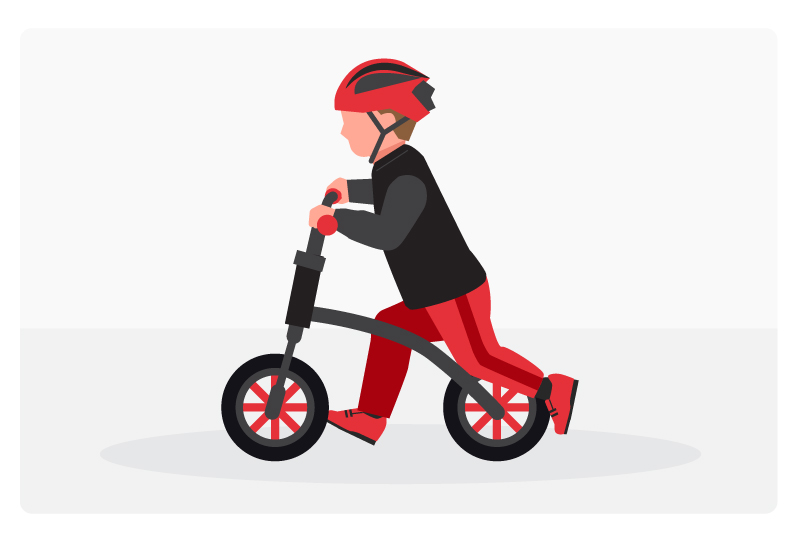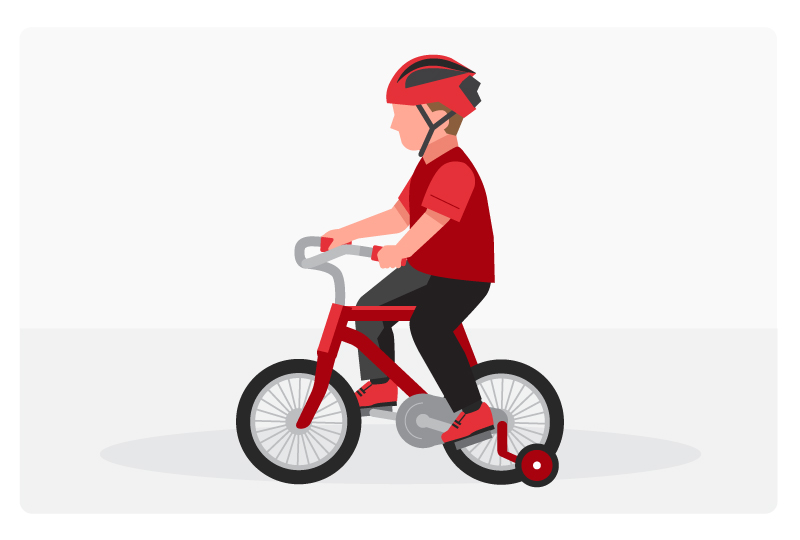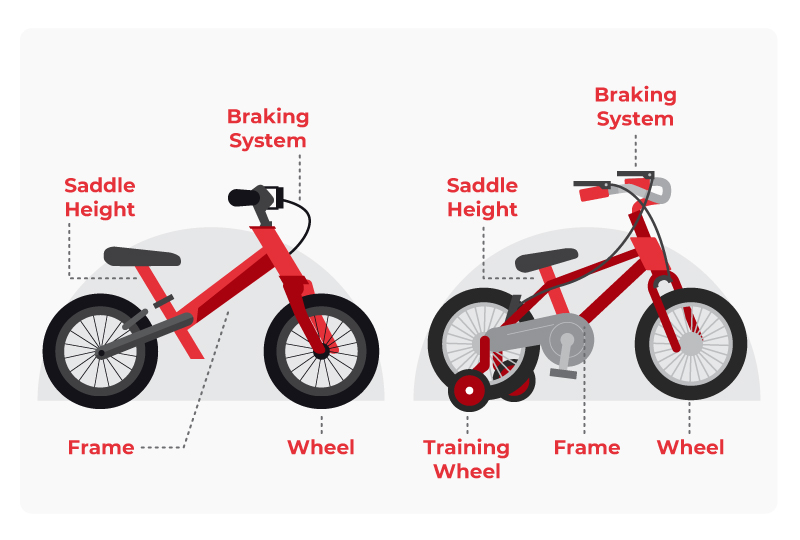If your toddler is at the right age to be taught how to ride a bike, you may be wondering what type of bike to start his lessons with.
But there’s a divided opinion as to the pros and cons of using a balance bike versus a bike with training wheels. Is one better than the other? Will your kid learn faster with one over the other?
In this post, we’ll give you the significant distinctions between these two types of bikes, so you’ll know the best way to introduce your kid to the joys of pedaling through neighborhood roads and making the most out of their childhood years.
Table of Contents
Understanding Balance Bikes And Training Wheels
First off, let’s start defining these two bikes, how they work, what they’re generally made of, and how your kid can use them to learn how to ride their first real bike.
What Is A Balance Bike?

Balance bikes are aptly named, as they are bikes used to learn how to stay upright while sitting on the saddle and cruising through the road. One thing to note, though, these don’t have pedals attached.
They’re suitable for kids who are already comfortable at walking as they mainly will use this to walk (then progress to running) while on the saddle, pushing themselves forward. Practising this over and over without pedaling will teach them the fundamental skill needed in cycling.
For some children, this actually makes the transition to a proper bike easier. Once they learn how to glide, they can then learn how to coast, lifting their feet off the ground as they glide and slowly learn how to balance.
Once they master this balancing act, that means they’re ready to take the next step – pedaling.
What Are Training Wheels?

Bicycles with training wheels are miniature versions of a classic bike with all the parts – cranks, pedals, chain, front and rear wheels plus an additional pair of smaller wheels at the back to serve as stabilizers.
The child rides the bike, pedaling while being kept upright by the training wheels. Some recommend lifting these wheels by an inch on each side so he can learn to pedal and balance while still having training wheels to catch them if they tilt while pedaling.
Once the stabilizers are removed, though, they will probably have to learn to balance all over again while pedaling – which may be a lot harder.
A couple of advantages when learning with training wheels is that it will prepare your child in managing falls, especially when making turns. It will also help them build the leg muscles needed in handling a proper bike.
How They Work

Although we’ve discussed a few of the components present (and missing) in these bikes, there are more distinctions in their construction.
Frame
Balance bikes are commonly manufactured using aluminum and plastic. There is a preference for aluminum as they make the frame of the bike lightweight yet strong and durable at the same time.
Bikes with training wheels, on the other hand, are usually made of steel, much like regular bikes. Although there are some brands that make them with aluminum, too. A steel frame, combined with pedaling to move essentially two pairs of wheels, makes these bikes quite heavy.
Wheels and Tires
Balance bikes can have rubber tires or EVA foam. EVA foam tires are puncture resistant and lightweight, but they wear out easily and offer little in the way of gripping surfaces. Rubber tires provide better traction and shock resistance, making them safe for kids when they turn corners.
Like traditional bikes, kid’s pedal bikes will almost always have rubber tires, while the smaller stabilizer wheels will typically be made of hard plastic. The mounting brackets of these wheels often bend with time, making the bike lean further down on one side compared to the other.
Saddle Seat Height
As children use their tiny little legs to keep the bike upright, balance bikes need to have low saddle seats to make the child more comfortable and able to walk or run with their feet flat on the ground while sitting snugly.
Bikes that come with training wheels need to have higher saddle seats so the child can assume the right sitting position where their legs are almost straight at the bottom of the pedal stroke. Typically on these bikes, they’ll only be able to reach the ground with the tips of their toes.
Brake Systems
While some balance bikes don’t come with brakes at all (they’d have to stop the bike with their feet), many do have rear brakes only. Still others have front and rear brakes. For the safety of your little one, we recommend getting a balance bike with at least one brake.
Like grown-up bikes, kids’ pedal bikes will typically have front and rear brakes, which can employ either v-brake, side-pull, or coaster brake systems.
Balancing and Pedaling

Balance bikes teach kids how to stay in an upright position first before even learning the technical skill of pedaling. Once they gain this very basic skill, pedaling and slowing or stopping the bike completely immediately becomes quite a natural next step that’s easy to transition to.
Learning with training wheels will immediately immerse the child into the skill of pedaling and teaching them not to fear toppling over, as is a common occurrence with these bikes.
A drawback is the child will rely on the stabilizers for longer than is necessary, so be sure to monitor their progress and know when to raise the training wheels higher to ease your kid into riding a bike without the immediate help of training wheels.
Turning and Steering
Since balance bikes are not heavy at all, have low saddle seats, and don’t have stabilizers to hinder side movements, turning corners can be great fun for them as they can simply lean into a corner and steer their handlebars slightly.
Your child can steer a bike with training wheels by leaning, a natural human inclination. And since the stabilizers force the bike to stay upright, it can make it difficult to turn – especially adding to the fact that he needs to pedal against the weight of the bike.
This is the reason kids fall off from riding bikes with training wheels more than they do from riding balance bikes.
Are Balance Bikes Better Than Training Wheels?
While balance bikes are suitable for most surfaces, you should have your kid use them only for sloping surfaces if it has a built-in braking system (unless you want to hover over him during the entire bike ride!). It’ll be much easier for him/her to control his speed on even terrain.
The small training wheels can be difficult to maneuver on inclined slopes as they will topple over sideways, don’t turn over on rough surfaces, and dig into gravel or soft ground making the bike even heavier for your little one, which can be frustrating.
There are just too many perks to using a balance bike as opposed to bikes with training wheels that we just can’t overlook their benefits.
Although some claim balance bikes are an added expense when teaching kids to ride because then they won’t be usable when their kid transitions to proper pedal bikes.
But if you consider all the things you spend for your child, what’s a little more to help him ease into cycling faster and without going through many dangerous falls (or worse, injuries)?

